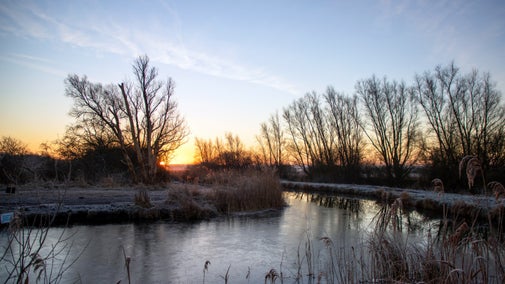
Donate to make a difference
Your support is essential to help us look after nature, beauty and history. Make a donation today, and together we can protect precious places for everyone, forever.

As a conservation charity, protecting wildlife at our places is at the core of our values. Many of the old buildings and manor houses that we care for are ideal roosting sites for bats. Discover what makes a good habitat for bats, and what we’re doing to protect them.
In the 1970s experts found evidence of widespread decline of bat species in Britain. This led to all 18 species, 17 of which are breeding, being protected by law in 1981.
Since then, there has been some proof of recovery within the bat population, but some have shown very little change from what was already low numbers. The reasons for lack of recovery are thought to be loss of roost sites, especially in buildings; loss of feeding habitats, especially in farmland; and in some cases, direct persecution.
Climate change means that some bats are extending their range to the north of the country as it’s becoming warmer, which allows them to live there. During winter hibernation, if the temperature reaches over 7 degrees and insects are flying, bats wake up to feed before going back to sleep.
To help bats thrive, in addition to roosting sites, they need easy access to feeding sites. They like areas free from light pollution, woodland avenues and long bushy hedgerows so they can move between spots without being exposed in the open.
There are 18 species of bat in the UK, and all of these can be found at some of our special places. In fact, the National Trust is the single biggest owner of bat roosts in England, Wales and Northern Ireland.
Jo Hodgkins, Nature Conservation Advisor, explains the type of habitat that bats are attracted to.
Bats roost in small crevices in natural ‘structures’ such as cracks in cliff faces, caves or splits and holes in trees.
Mottisfont has an international designation for the rare Barbastelle bats in its Hampshire woods, and the Isle of Wight has rare Bechstein’s bats in Borthwood Copse. Ashridge, on the Buckinghamshire/Hertfordshire border, has lots of cracked and creviced veteran trees for bats to roost in. They’re not always put off by lots of people – there’s a noctule bat roost near the busy Bridgewater Monument at Ashridge, Hertfordshire.
Built structures, such as bridges, houses, churches, barns also make great homes for bats.
At Basildon Park in Berkshire, a survey recently found serotine bats roosting in the stable block and brown long-eared bats using it as a maternity roost.
Stowe’s elegant temples house brown long-eared and Natterer’s bats, while The Vyne has whiskered and brown long-eared bats in the mansion roof space.
The bat tower at Toys Hill in Kent was once used as the water tower for the Weardale estate. After suffering damage in the 1987 storm, the tower was converted into a bat hibernaculum. The tower is well used by bats and they seem to like hanging out in their high-rise home.
Cellars, mines, ice-houses and tunnels provide sheltered, cool, relatively humid microclimates for hibernating.
Hughenden in Buckinghamshire has brown long-eared and Natterer’s bats hibernating in one of its secret underground war bunkers. A disused rail tunnel on one of our estates in West Sussex is a vital bat hibernation site with some rare species.
And we mustn’t forget Cliveden in Buckinghamshire. Its South Terrace hosts one of the most important bat sites in the country, with eight species swarming here between August and October. We don’t know exactly what they swarm for. It’s a big social get-together before hibernation which could suggest mating.

We’re at the forefront of bat conservation in the UK and produce advice for builders, conservators and woodland managers who encounter bats.
A conservation project at Wilderhope Manor demonstrated why careful planning is vital to protect the homes of bat colonies in our older buildings.
A dusk and dawn survey at Wilderhope prior to starting work, indicated the presence of summer roosts of Brandt’s bat, brown long-eared bats and common pipistrelle bats. In preparation for winter, bats’ hibernating period, temporary alternative bat-roosting provisions were built within neighbouring buildings.
An ecologist observed the work at Wilderhope as it happened, and noted down the location of bat roosting sites as the roof slates were removed. He also advised on mitigation measures throughout the work, including providing a number of small gaps in the slates and roofing felt to allow bats to access the batten void and roof-spaces.

Our big country houses and their stable blocks provide the perfect environment for bat roosts, warm enough and private for breeding. We have a special responsibility within the UK and Europe for the care of the bat population.
The wildlife mitigation strategy was successful; monitoring is ongoing but during summer 2016 it was found that the bat colony and a colony of nesting swifts had returned to the building.
One of our aims is to help increase the size and number of wildlife-rich habitats so that they can join up better. We work in partnership with the Bat Conservation Trust and volunteers to look at how bats are faring on National Trust land. We can then use the information collected to measure how well we’re doing at restoring a healthy, beautiful natural environment.
When you visit one of our places to see nature up close or join a specialist bat walk, you help us maintain our commitment to wildlife conservation.
Find out more about the National Bat Monitoring Programme

Your support is essential to help us look after nature, beauty and history. Make a donation today, and together we can protect precious places for everyone, forever.
Reducing carbon emissions, planting trees and protecting wildlife habitats: just some of the things we’re doing to protect nature and the climate.

The places we look after are home to every kind of bat that lives in the UK. Use our handy guide to identify different species and find out where to spot them.

Red squirrels are protected at our places. Discover more about the safe havens we are providing for these fascinating creatures.

Discover how we’re helping increase butterfly populations through habitat management and monitoring, and learn about the rare species we’re bringing back from the brink.

Otters were on the brink of extinction in the UK in the 1960s, but a nationwide conservation effort has seen their numbers bounce back. Find out what our rangers and volunteers are doing to help.

Numbers of hazel dormice have declined rapidly over the last century as a result of loss of woodland habitats and competition for food. Learn about our work to protect these endangered mammals.
